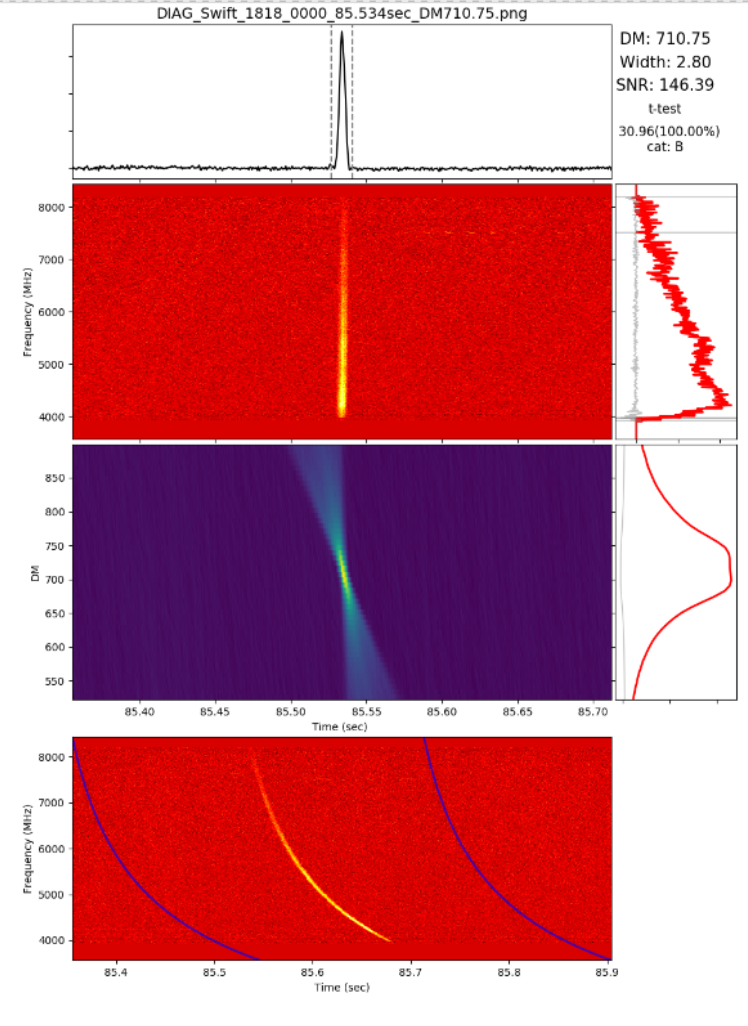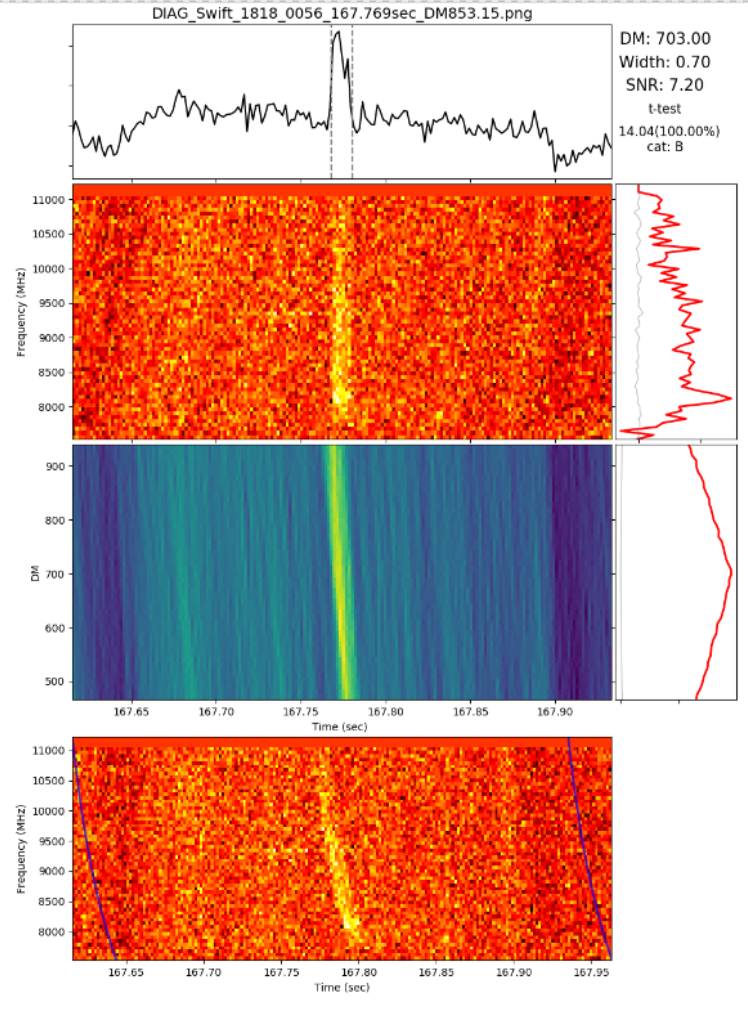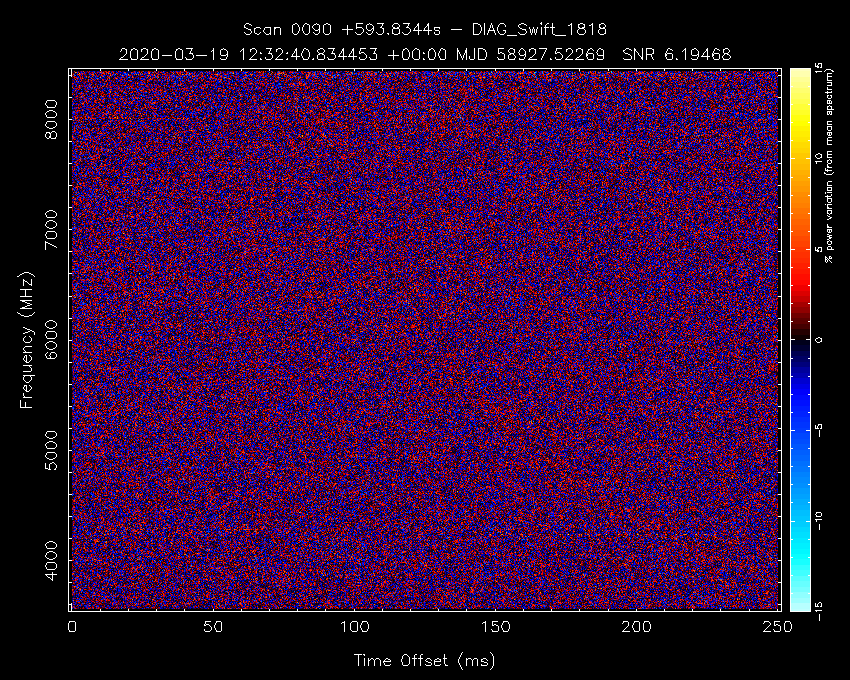Detection of a new magnetar candidate across 4 - 11 GHz with Breakthrough Listen at GBT
We report a detection of Swift J1818.0-1607 across 4 to 11 GHz (C and X-bands) using the Robert C. Byrd Green Bank Telescope (GBT) and the Breakthrough Listen digital backend (MacMahon et al. 2018, PASP, 130, 044502). The Breakthrough Listen Initiative is conducting a wide ranging search for observational indicators of extraterrestrial civilizations (technosignatures), including observations of a variety of exotic objects such as magnetars (Lacki et al 2020 in prep).
On UT 2020 March 12, 21:16:47 the Swift Burst Alert Telescope reported outburst activity from SGR Swift J1818.0-1607 (GCN circular 27373). Following up on this activity, NICER reported a coherent periodic feature with 0.733417(4) Hz periodicity and suggested the source to be an active magnetar. Several radio follow-up campaigns (ATels #13353, #13554, #13559, #13560, #13562, #13569) detected radio pulsation from the source below 3 GHz. Karuppusamy et al. (ATel #13553), reported the first detection at 1.4 GHz at the DM of 706(4) pc-cm^-3 from the Effelsberg radio telescope, with a followup confirmation by Rajwade et al. (ATel #13554) and Champion et al. (ATel 13559) from the Lovell Telescope, and Lower et al. (ATel #13562) from the MeerKAT telescope at similar frequencies. Mann et al. (ATel #13560) reported a 2 GHz detection from the GBT suggesting a spectral index of -1.8(3). Champion et al. (ATel 13559) carried out observations at 6 GHz with 4 GHz of instantaneous bandwidth using the Effelsberg telescope with no detection.
Using the GBT, we carried out a 600 second observation on UT 2020 March 19, 12:22:47 at 6 GHz with 4 GHz instantaneous bandwidth (C-band), immediately followed by another 600 second scan at UT 13:07:57 at 9.3 GHz with 3.7 GHz of instantaneous bandwidth (X-band). Observations were recorded as GUPPI-formatted baseband voltages (Lebofsky et al. 2019, PASP, 131, 124505). Data were processed with a bespoke GPU-accelerated pipeline to convert voltages to high temporal resolution SIGPROC formatted filterbank products, and voltages were preserved. We used the periodicity of 0.7334110 Hz reported by Enoto et al. (ATel #13551) and DM of 703 pc-cm-3 (Rajwade et al. ATel #13554) to produce folded profiles at both bands. Data affected by RFI were flagged using PSRCHIVE tools.
At C-band, we found a prominent profile with integrated S/N of around 16. Based on the radiometer equation we estimate that the approximate peak flux density of the detection is around 0.04 mJy. We only included the lower 2 GHz of C-band for the integrated profile. Upon closer inspection, we noticed that this average profile actually consists of a few intermittent, prominent, and bright bursts instead of regular weaker single pulses (see linked figure). At X-band, we did not find a significant profile. A separate search for single pulses was undertaken for both the C-band and X-band data, using the technique described by Gajjar et al (2018, ApJ, 283, 2).

The preliminary analysis detected 29 single pulses across 4 - 8 GHz with S/N ranging between 6.2 to 146, corresponding to peak flux densities of 21 to 500 mJy.

We also report a marginal detection of a weak burst across 8 - 11 GHz from these observations with a S/N of around 7.2 at the DM of 703 pc-cm^-3. This corresponds to a peak flux density of around 40 mJy.

We report a wide variety of single pulses with multiple sub-pulse components and varying pulse widths (see linked figures), similar to other radio magnetars (Pearlman et al. 2018, ApJ, 886, 17; Maan et al 2019, ApJ, 882, 9; etc). A leading theory for Fast Radio Bursts (FRBs) is that they originate from magnetars; however, most FRB searches have been undertaken at lower frequencies (< 3 GHz). Our detections suggest that many FRBs are likely to be active above 4 GHz, given flatter spectral indices of radio emission from magnetars. Detection of bright single pulses further supports these claims.

Plots for 29 single pulses detected across 4 - 8 GHz
These observations suggest that Swift J1818.0-1607 is still active and we encourage further follow-up observations.
We thank the GBT staff for all their help during these observations.
We are releasing all of our data taken during these observations to the community.
Download SIGPROC filterbank file from C-band observations
Download SIGPROC filterbank file from X-band observations
Baseband data are available here for download
Data are released under the CC BY 4.0 license. If you make use of these datasets for academic work, please cite Gajjar et al. 2020 ATel 13575
If you have any questions, please do write to me at [email protected]
